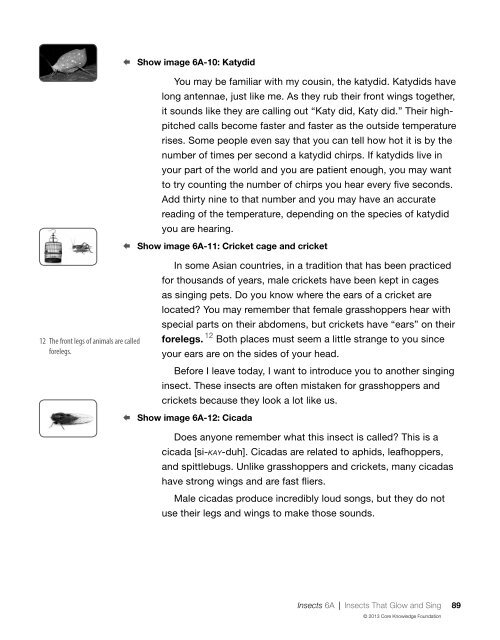Read-Aloud Anthology - EngageNY
Read-Aloud Anthology - EngageNY
Read-Aloud Anthology - EngageNY
Create successful ePaper yourself
Turn your PDF publications into a flip-book with our unique Google optimized e-Paper software.
Show image 6A-10: Katydid<br />
You may be familiar with my cousin, the katydid. Katydids have<br />
long antennae, just like me. As they rub their front wings together,<br />
it sounds like they are calling out “Katy did, Katy did.” Their highpitched<br />
calls become faster and faster as the outside temperature<br />
rises. Some people even say that you can tell how hot it is by the<br />
number of times per second a katydid chirps. If katydids live in<br />
your part of the world and you are patient enough, you may want<br />
to try counting the number of chirps you hear every five seconds.<br />
Add thirty nine to that number and you may have an accurate<br />
reading of the temperature, depending on the species of katydid<br />
you are hearing.<br />
Show image 6A-11: Cricket cage and cricket<br />
12 The front legs of animals are called<br />
forelegs.<br />
In some Asian countries, in a tradition that has been practiced<br />
for thousands of years, male crickets have been kept in cages<br />
as singing pets. Do you know where the ears of a cricket are<br />
located? You may remember that female grasshoppers hear with<br />
special parts on their abdomens, but crickets have “ears” on their<br />
forelegs. 12 Both places must seem a little strange to you since<br />
your ears are on the sides of your head.<br />
Before I leave today, I want to introduce you to another singing<br />
insect. These insects are often mistaken for grasshoppers and<br />
crickets because they look a lot like us.<br />
Show image 6A-12: Cicada<br />
Does anyone remember what this insect is called? This is a<br />
cicada [si-KAY-duh]. Cicadas are related to aphids, leafhoppers,<br />
and spittlebugs. Unlike grasshoppers and crickets, many cicadas<br />
have strong wings and are fast fliers.<br />
Male cicadas produce incredibly loud songs, but they do not<br />
use their legs and wings to make those sounds.<br />
Insects 6A | Insects That Glow and Sing 89<br />
© 2013 Core Knowledge Foundation

















